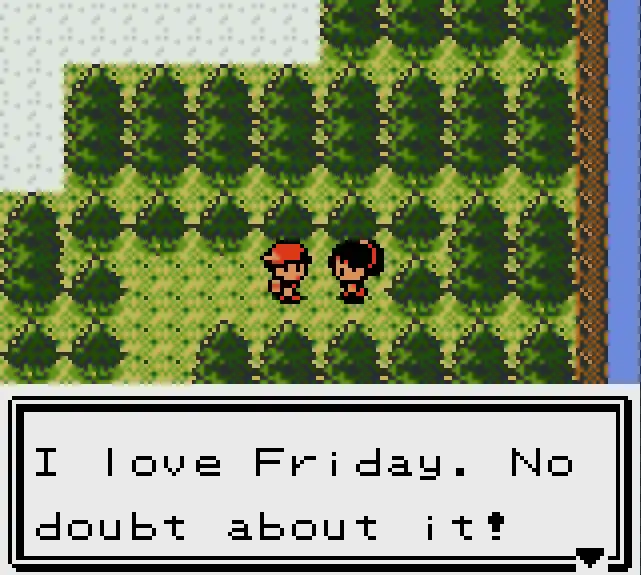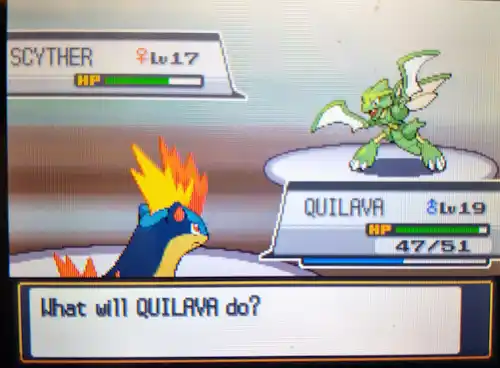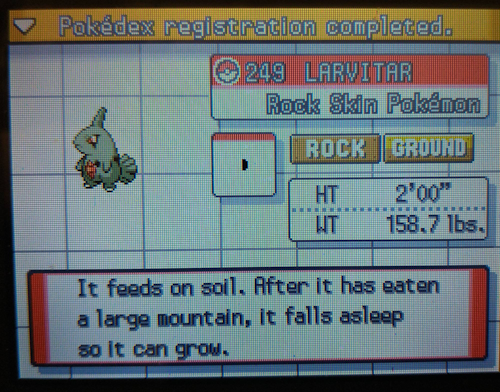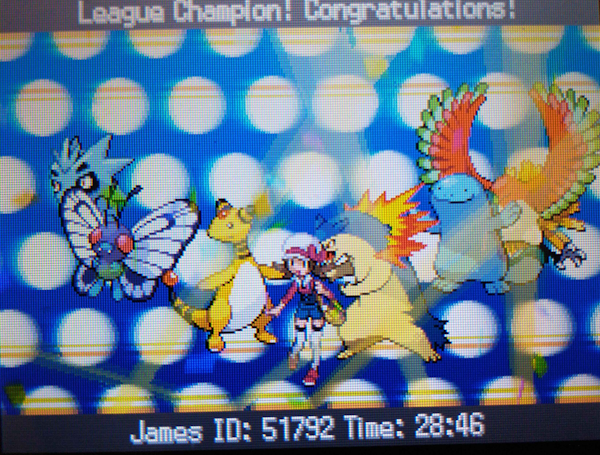Pokémon HeartGold Review
10/28/2024
Editor James here. I realized I used a lot of terms that are familiar to Pokémon fans, but might be confusing to anyone else. Rather than explain them all in the main text, I did my best to explain here...
- Generation 2 refers Gold, Silver, and Crystal versions. HeartGold and SoulSilver are Generation 4 games. I sometimes shorten this to "GSC".
- Generation 4 includes Diamond, Pearl, and Platinum, as well as HeartGold and SoulSilver. HeartGold and SoulSilver are sometimes shorted to "HGSS".
- The Physical/Special split is a mechanical change introduced in Diamond and Pearl that decoupled move types from the kind of damage they dealt. Originally, all Fire moves were always Special, all Flying moves were always Physical, etc etc. The linked page goes into more detail. Going forward from Diamond and Pearl, individual moves were either Physical or Special, regardless of type.
- "Screens" refers to a pair of defensive moves. Reflect and Light Screen. They reduce damage from Physical or Special moves respectively.
My love for the Pokémon franchise should be well known to all by now, but I still haven't played every mainline game in the series. Sorry, Alola! One of the biggest holes in that catalog was HeartGold and SoulSilver. And for many, many years after its release, I had heard it was a major contender for the best Pokémon game of all time. It's a shame too, because when asked what my all time favorite is, the original Gold/Silver/Crystal are ones I would frequently nominate.
Listen. I had a DS, and at least one friend who was loving the game. But I didn't have unlimited money, and especially in the DS era, Pokémon (and other great games!) releases were frequent. So, often, I would spring for the newest games in a generation, and not later ones. I had Ruby, but no Emerald. I did have LeafGreen at the time. I had Pearl, but no Platinum or HeartGold/SoulSilver. I had Black, but no Black 2. That was the pattern at the time.
I finally decided it was time to see this game for myself. What did I find? Well...
The Originals

Before we dive into HeartGold, I feel I must elaborate on my relationship to the original games.
I am on the younger side of PokeMania. The exact day Red & Blue hit store shelves in America, I don't think I had my sentience or reading ability. Kids older than me, actual school age kids, were trading cards (and getting them banned in school), trading over Link Cable, and begging their parents to go see The First Movie at the theater.
I would play Red, pretty much as soon as I could read a little bit. I played it a lot, and did many playthroughs, for years and years even well after Gen 3. I'm lucky I developed good reading skills, and I'm certain Pokémon assisted me in that. Gold & Silver were released in the States when I was a much more cognizant kid. To me, they were essential as oxygen. While I didn't really have any friends at the time to trade or talk with, these games were huge, seemingly endless adventures of discovery and excitement. I'm fairly certain I played my copy of Silver every day for at least a year.
Gold & Silver, to me, are completely quintessential Pokémon, if not foundational life experiences. These games are filled with memorable scenes that stuck with me for life. I remember the first time I used Surf in the Ruins of Alpha and discovered Natu and Xatu. Lance's raid on the Team Rocket hideout, and the Red Gyarados at the Lake of Rage. Clair and the Dragon's Den. "You just stepped into KANTO!", trying to win the Bug Catching contest, getting rare glimpses of the elusive Entei (my favorite), Suicine, and Raikou. The graphics and sound are still absolutely delightful.
This is a sweet memory and nothing more, but on one childhood playthrough, I named my Sentret "Scout", based on the card from Neo Discovery. Scout, you were a good Furret! I still remember you, too.
Am I blinded by nostalgia? Almost certainly. But I did a playthrough of Gold in 2016, and Crystal in 2022. I replayed them for my own love and fun, and also to make sure I'm not completely crazy when I think back on the fun experience I had. I simply do not share many of the common criticisms of these games, not that they appear to be widely derided. Still, I would like to address them, so we can discuss what HeartGold did (or didn't) do differently.
The most common complaint, I feel, involves the level curve and difficulty scaling of the game. After the player reaches Ecruteak City and defeats Morty, they have access to Surf and can tackle a few objectives with some freedom. The downside of this is that the level of Wild Pokémon remains in the teens to twenties (when you get out far enough, it does get better), which makes battling for EXP potentially tough. Depending on your playstyle and team building decisions, you might be under-leveled for, say, the Elite Four.
In my playthroughs of Gold and Crystal, I did not have to do much additional training that I would consider outside the realm of normalcy. In Crystal, I was able to defeat Red with a team of Pokémon in their low 50's, at best! I hit a few bumps in places. Karen was the most difficult of the Elite Four for my particular team, but most teams in Pokémon games cannot handle absolutely everything by themselves. Except Nidoking.
Another complaint is that the new Johto Pokémon are somewhat weak compared to their Kantonian brethren. This one has some more truth to it, when looked at simply stat values, types and move pools, a lot of the 100 new Pokémon are a little undercooked. It's hard to go in-depth here without wasting a bunch of time, but just be aware of it. I would say in broad strokes, it's more or less true, but doesn't usually the game experience in significant ways.
What is the Gold and Silver Experience?

Now you know that I'm not even a little impartial, but willing to acknowledge some pain points. Let's talk about what I consider, after multiple playthroughs of the games, to be the general experience and uniquities to GSC that any remake should try to hit upon. This is the stuff I was scared about a remake messing with.
- Immersion through daily events and the clock.
- Exploration rewarded with new battle strategy opportunities.
- Red
One of the biggest feature that defines Gold and Silver's play is the real time clock. The first thing you must do upon booting the game is set the time. Different Pokémon can appear in the Wild at different times of day. NPC Trainers will call you to alert you of Swarms, Berries will regrow after a day, Kurt will finish making your Apricorn Balls, etc.
This "dailies" aspect is something that is mentioned by Pokémon YouTuber Tama Hero. There are things I agree with and really disagree with in that video, but I wanted to mention it because she explains the appeal well.
This aspect of the game is much more notable in the back half than in the front, when you are slowly being introduced to these things pre-Fly. It's also a little less prominent without some friends playing alongside you, but it's an engaging roleplaying experience all the same.
This is an element of most classic Pokémon games, but I feel Gold and Silver have a different emphasis on it than the games it's sandwiched between. Ruby and Sapphire, in particular, have their own, very commendable things going on.
Gold and Silver can reward you quite handsomely for developing familiarity with its world, which is something that combos well the above feature. Did you know you can get Metal Coats from the Magenmite in the Route before Olivine City? They're rare, but they are there. You can pick up Dig at the National Park, which is a very serviceable Ground type move for the early game. As a kid, when I would get the Miracle Seed, I would think "Alright!!" (I almost always use Grass starters, as a default). Those are just two examples, but interesting things are littered around everywhere. I think every Pokémon game is enhanced by familiarity, but the way GS is structured invites the player to create that familiarity.
Big power-ups in the game don't always come from your Pokémon leveling up their raw stats. Sometimes one good move, that you found out in the world (or gambled for in the Game Corner!) will be the biggest upgrade you can get. Helpful items, or interesting additions to your team, it's up to you to strategize, plan, and train with what you pick up and discover. How much of that is intentional design, versus being a byproduct of having a somewhat weak pool of Pokémon early on, may be up to taste. I've always found it to be engaging.
In the middle of both of those features is Pokémon Breeding. If you're really advanced, (or have a guide, like I always need when I do this) try breeding your Pokémon at the new Day Care Center. This might be the biggest thing that stuck around for future Pokémon games, and it's a lot of fun here if you can get a grip on it and are willing to put in some effort to more specially raise your Pokémon.
The thing that puts the game through it's biggest paces is the final challenge, battling Red on the top of Mt. Silver. I have a lot I want to say about Red, but I think it's the greatest ending to a Pokémon game, by far. It's not really so much about Red being some kind of badass (he seems pretty well regarded by everyone in-universe though!) or being an extremely high leveled opponent. Lots of opponents in GSC can be above your level depending on your exploration level and battling. Good strategy goes much farther than levels do. To me, Red represents that you've grown up, beyond even yourself the last time you grew up (in Red and Blue).
It is also something that is fun to prepare for and challenge yourself with. I say that Red is, at least by Pokémon standards, a superboss. You don't have to do it, necessarily, if you don't want to. It can take a lot of time to prepare for and train up to. That's the way it should be, in my opinion! It fits well with everything other thing about the game's structure. GSC and HGSS both deem Red's defeat worthy of playing the credits a second time afterwards, and both games also withhold the beautiful, melancholic "The End" theme for conquering Red as well. I think it's fair to say that it's important.
This Is The HeartGold Part

So how does HeartGold handle what I've outlined?
In short: With grace, and remarkable understanding of what made the originals so great.
I had to admit, I was impressed. My fear was that these remakes would some how sand-off my beloved memories of Gold and Silver. But the longer I played and deeper I looked, the more brilliantly the game shined.
Let's start with the technical. The Physical/Special move split that was introduced earlier on the DS in Diamond & Pearl is one of the best features of Gen 4. It's a good thing in the Johto region, too. Broadly, I think more Pokémon are more easily usable in HeartGold because of this change. There's no more Elemental Punches Alakazam (or specifically Fire Punch Ampharaos for sick Grass coverage). But now, Noctowl can utilize its Flying typing and passable Special Attack stat on something like Air Slash instead of being mostly a waste. There are little examples like that everywhere. Some Pokémon are affected by it more than others, but it's a great system update I've never had an issue with.
Even better than that, ove pools were expanded, often greatly, for a lot of the Pokémon. This is undoubtedly a good thing. Especially since Diamond and Pearl introduced some of the most cracked and iconic moves into the series that are still popular today. You wanna breed the famous Aqua Jet onto your Totodile? Do it. Take control of those EVs and really get into crafting some Pokémon from scratch. Use Feraligatr's (another huge winner of the Physical/Special split) monster Attack stat more than ever before! If you want a really extreme example, check out poor Foretress' learnset in the originals and then the remake. Quite the transformation, wouldn't you say?
Abilities got introduced in Gen 3, and I think it goes without saying that it adds to amusement and playability. In my case, I stopped being able to count the times that my Quagsire's Damp Ability stopped a Graveler from Exploding in my face. Not the optimal Ability, but it was fun and enhanced my playthrough. Other Johto buddies like Steelix or Scizor get Abilities that can drastically change up their playstyles and boost their viabilities.
So, general Pokémon mechanics that had changed in the past ten years were a huge boost for these games. But there are a lot of other smart choices that elevate the experience.
More Availability Is Always Good!

Many of the Gym Leaders rewards have been switched up. Remember how I said that one move can make all the difference? Good moves are definitely appropriate rewards for beating a Gym, this is a mainstay of Pokémon. Most notably in the very early game, Falkner now gives Roost instead of Mud-Slap. Bugsy now offers the absolutely amazing U-turn(!!) instead of the merely acceptable Fury Cutter. These two alone are genuine game changers. Chuck gets a sort of side-grade in offering Focus Punch instead of DynamicPunch. Clair rewards the more widely usable Dragon Pulse over DragonBreath (not a bad move, but only a few Pokémon can learn it at all). It adds up very nicely.
The famous Goldenrod Department Store has also changed. The GSC store had the elemental punches for sale, which are fantastic moves. The HGSS store now offers, as soon as you get there, mainstay powerhouse, endgame level moves. Fire Blast, Thunder, Solar Beam, Focus Blast (lmao), and both Screen moves. This is insane! I would like to personally thank my Typhlosion and Fire Blast for being there for me in tough times.
Your midgame upgrade is the brand new Johto Safari Zone. This is a staple of early Pokémon that the Bug Catching Contest in the National Park didn't quite replace. I am just about always in support of these kinds of features. The Grand Underground in Brilliant Diamond & Shining Pearl is a godsend for a pair of games that might otherwise have the worse selection of Wild Pokémon in the series. Far future games Sword & Shield and Scarlet & Violet also have features (well, SV is like an open book, more or less,) to enable some extra interesting choices in your journey.
The most notable feature of the Johto Safari Zone is your ability to pick up Larvitar before you get to Kanto. I generally like the old design that the most powerful Pokémon are available later, and take some effort to train. I spent days raising my Salamence in my last Ruby playthrough. But even enjoying that, Pupitar and by extension, the famous Tyranitar come waaaay too late in Gold and Silver. It's a somewhat unreasonable ask, though certainly not impossible for the dedicated. Now you can get a much more reasonable start, which is what I did here, but there are plenty of other Safari Pokémon that could be to your interest.
All of this helps stabilize what I think could be reasonably argued as the weakest part of Johto. The early game simply cannot show its hand with how feature rich it really is, but HeartGold spices things up considerably, and helps create an engaging experience from the very start.
And yet still, there are more additions! The Battle Frontier returns as it was featured in Platinum, bringing with it a frankly dizzying amount of challenges, curiosities, goals, and rewards to work towards. I'll admit that I'm not usually the type to get deep into these Battle facilities (I did like the one in Sword/Shield for whatever reason), but its existence is very much appreciated and gives players more reasons to raise and play with more Pokémon than just their main six. That is a very good thing.
'Sploring and Running It Back

None of this takes away from the feeling that Johto is a place to be explored. Mt. Mortar is still optional and yours to discover. Have you been around the Union Cave with Strength and Surf? Be sure to revisit the Slowpoke Cave to get one and a King's Rock! Sneasler's are in the lower part of the Ice Path (just like Crystal). So on, and so on.
It is somewhat commonly complained that the Johto games require too many HM moves. For some fans, this is an enjoyable point of strategy. Or HM Slavery, your choice! I used a Sandshrew for Cut, Strength, and Rock Smash, and left the rest to my team, this time. Amusingly, HGSS actually adds a mandatory one. You must have Rock Climb to reach the top of Mt. Silver and face Red. You also only need Whirlpool and Waterfall a handful of times, and the new Move Deleter definitely softens the pressure of HM moves. It's still worth noting if you want to play, this is one aspect that was left alone, or possibly made more annoying!
I'd say it's worth organizing it however it suits you. Even after you get Fly, there are plenty of places to go back and mess around, trees to Cut, and boulders to Strength. You can get some Heart Scales for the Move Reminder from Rocks somewhat early on, so keep that in mind!
One of the best expansions and incentives to explore in the remakes comes with rematching Gym Leaders, a beloved feature by many. In HeartGold, you must catch your favorite Leaders hanging around in the world in certain spots and days to get their phone number. Once that is done, they can be called to reveal their availability for rematches.
I love this kind of stuff so much, it's not even funny. A day in the back-end of HeartGold goes like this. I wake up in the morning and call a few Trainers from the PokeGear to see who is up for a rematch. I know that X Gym Leader isn't ready until the afternoon, evening, or whatever, so I rematch whoever is available for some XP. This is repeatable for any given Trainer's timeframe. When a Gym Leader is ready, I'll take the train from Goldenrod to Saffron and have fun showing off my sick Tyranitar. Once I've had my fill of that, I might do some errands like pick up Apricorn Balls from Kurt, or restock on items if I need any. If no one's around to battle, I'll investigate whatever curiosity strikes me at the time, like the Safari Zone, or some cave I didn't fully clear out. Or maybe I'll hit up the Elite 4. My choice!
For me, it's this level of roleplaying and immersion that puts this game above many others. Many of these elements were in the originals, but things have been refined and expanded here to a fabulous level. In the originals, Trainers could rematch you, but only a scant few and they would have to call you. That still happens in the remakes, but you have much more agency in what your activities are.
As I work on this review, I'm still training for Red, doing what I described above. I can address him though after doing a few "test runs" of his battle. He has been made notably more difficult than in the original. In general, I think these remakes skew slightly harder than the originals, as Gym Leaders and the Elite Four get access to buffed and modern moves as well. One of Lance's Dragonite's has Outrage. Yeowch! Red's Pokémon now start in the eighties! They have better and more varied movesets too. Of course, you, the player, have much faster and plentiful methods for training than you did before, so I think it shakes out fairly. It's an awesome battle. I've got my strategy mostly worked out, but my team is getting hit hard, and I don't have a Screen setter this time. This is the thrill of battle!
The appeal of the original games, and what they set out to do, was correctly identified in HeartGold/SoulSilver. An immersive, beautiful region, filled with things to do, places to see, and people to meet. It's all brought to life in a way it only could have with 10 years of Pokémon design in the rear-view. It's a case of having your cake and eating it too. These games are modernized, but basically nothing was lost in translation. Someone really understood (or at least, shares a similar viewpoint!) what makes this game so special to those who love it, while enhancing those very same things. Johto (and Kanto) don't simply exist to be conquered and forgotten. They're places to live, play, and enjoy.
I still think you could play the originals and have a great time. For me, nothing really outdoes the Game Boy Color aesthetic and music, and that is a powerful draw. But being as fair as I can, it's hard not to look at these games and not be astonished with how good it really is.
Recently, I've been ranting a bit about how it seems like no game remake doesn't have an asterisk * on it. There's always something that's not there, that changes the experience, or some less than ideal graphical change, or the vibe is off, whatever. Game remakes are in a horrible position to exist in. You can never out-original the original, but a remake will inevitably draw comparisons and exist in its shadow. Somehow, eventually, there will be endless debate about "definitive" (yuck) experiences, community engagement, and personal enjoyment, all at odds with each other.
HeartGold has me rethinking that notion. It passes all my usual remake scrutinizing with flying colors befitting the Ho-Oh that soars over the region. The things from the originals that make it unique are intact, and modernizations are carefully done as to bring out the best of what the original games were going for. It's fresh, it's fun, and it's engaging all over again.
Now, if you'll excuse me, I've got to rethink what my all time favorite Pokémon game is. Again.
Thanks for reading~!
- Webmaster James